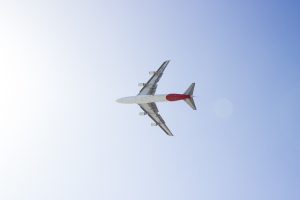
Most airplanes don’t have completely flat and smooth wings. Rather, their wings feature adjustable flight control surfaces. Elevators, for instance, are hinged control surfaces that allow pilots to control the airplane’s pitch. In addition to elevators, some airplanes feature stabilators as well.
What Is a Stabilator?
A stabilator is a flight control surface consisting of a hinged, horizontal stabilizer. It serves two purposes: to keep the aircraft stable and to control the aircraft’s pitch. As a result, stabilators combine the roles of stabilizers and elevators into a single flight control surface.
How Stabilators Work
Stabilators work by pivoting via a hinge. This is one of the ways in which they differ from traditional horizontal stabilizers. While traditional horizontal stabilizers are fixed, stabilators are not. Stabilators feature a hinge that allows them to pivot, which in turn changes the aircraft’s pitch.
Like with other adjustable flight control surfaces, pilots can control them from inside the cockpit. Pilots can essentially change the angle at which the aircraft’s nose points by adjusting the stabilator. To ascend to a higher altitude, the pilot may increase the aircraft’s pitch with the stabilator. To descend to a lower altitude, on the other hand, the pilot may decrease the aircraft’s pitch. Regardless, the entire surface of a stabilator will move up and down.
When the stabilator tilts up, the aircraft’s tail will push down. This forces the aircraft’s nose to rise. When the stabilator tilts down, the tail lifts up. This forces the nose to drop. The stabilator allows pilots to control the aircraft’s pitch by forcing the nose to rise or drop.
Why Airplanes Have Stabilators
Stabilators provide pilots with better control over the aircraft with which they are used. As previously mentioned, the entire surface of a stabilator will move. Therefore, stabilators offer more control than traditional elevators. Many fast airplanes, such as military jets, feature stabilators for this reason.
Stabilators can also reduce drag. This is because they serve two purposes. Stabilators keep the aircraft stable and control the aircraft’s pitch. By combining these functions into a single flight control surface, stabilators can lower the aircraft’s total weight and reduce its drag. The end result is improved fuel efficiency.
In Conclusion
Not all airplanes have a stabilator. Most modern commercial airliners, for instance, only have a horizontal stabilizer and an elevator control. Nonetheless, stabilators are common on military jets and other specialized aircraft.



